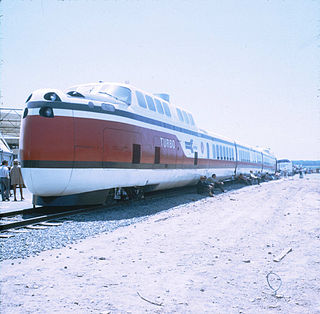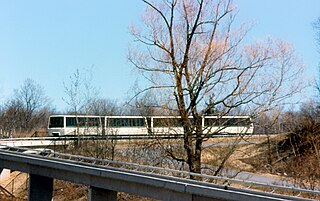Bibliography
Notes
- ↑ Fichter 1964
- ↑ Boyle 2006 , p. 13
- ↑ Bradbury-Downs-Small 1982, p. 28. - "Ninety-five percent of cities with populations greater than 100,000 people in the U.S. lost population between 1970 and 1975."
- ↑ Haar-Cole-Merritt 1968
- 1 2 3 4 5 6 7 AGT 1975 , p. 250
- 1 2 Ishii-Iguchi-Koshi 1975, p. 77.
- 1 2 3 Ishii-Iguchi-Koshi 1975, p. 78.
- 1 2 3 AGT 1975 , p. 251
- 1 2 AGT 1975 , p. 252
- ↑ AGT 1975 , p. 257
- ↑ "Expo '75 - Publicity Photos" . Retrieved 7 July 2021.
- 1 2 Anderson, John Edward (August 4, 1996). "Some Lessons from the History of Personal Rapid Transit". pub. Retrieved December 26, 2009.
- ↑ California: "Safety Rules and Regulations Governing Light Rail Transit" (General Order 143-B) Archived 2009-12-31 at the Wayback Machine
- ↑ California: "Rules and Regulations Governing State Safety Oversight of Rail Fixed Guideway Systems" (General Order 164-D) Archived 2009-12-31 at the Wayback Machine
- ↑ California General Order 164-D, ibid. Sections 1.3,1.4
- 1 2 Ishii-Iguchi-Koshi 1975, p. 82.
- 1 2 3 AGT 1975 , p. 253
- ↑ Ishii-Iguchi-Koshi 1975, p. 81.
Related Research Articles

Personal rapid transit (PRT), also referred to as podcars or guided/railed taxis, is a public transport mode featuring a network of specially built guideways on which ride small automated vehicles that carry few passengers per vehicle. PRT is a type of automated guideway transit (AGT), a class of system which also includes larger vehicles all the way to small subway systems. In terms of routing, it tends towards personal public transport systems.

A people mover or automated people mover (APM) is a type of small scale automated guideway transit system. The term is generally used only to describe systems serving relatively small areas such as airports, downtown districts or theme parks.

An automated guideway transit (AGT) or automated fixed-guideway transit or automatic guideway transit system is a type of fixed guideway transit infrastructure with a riding or suspension track that supports and physically guides one or more driverless vehicles along its length. The vehicles are often rubber tired or steel wheeled, but other traction systems including air cushion, suspended monorail and maglev have been implemented. The guideway provides both physical support, like a road, as well as the guidance. An automated line can be cheaper to run than a conventional line, due to the shorter trains and stations.
Various terms are used for passenger railway lines and equipment; the usage of these terms differs substantially between areas:
Cabinentaxi, sometimes Cabintaxi in English, was a German people mover development project undertaken by Demag and Messerschmitt-Bölkow-Blohm with funding and support from the Bundesministerium für Forschung und Technologie. Cabinentaxi was designed to offer low-cost mass transit services where conventional systems, like a metro, would be too expensive to deploy due to low ridership or high capital costs.

Morgantown Personal Rapid Transit is a personal rapid transit (PRT) system in Morgantown, West Virginia, United States. The system connects the three Morgantown campuses of West Virginia University (WVU) and the city's downtown area.

Ultra is a personal rapid transit podcar system developed by the British engineering company Ultra Global PRT.
Headway is the distance or duration between vehicles in a transit system measured in space or time. The minimum headway is the shortest such distance or time achievable by a system without a reduction in the speed of vehicles. The precise definition varies depending on the application, but it is most commonly measured as the distance from the tip of one vehicle to the tip of the next one behind it. It can be expressed as the distance between vehicles, or as time it will take for the trailing vehicle to cover that distance. A "shorter" headway signifies closer spacing between the vehicles. Airplanes operate with headways measured in hours or days, freight trains and commuter rail systems might have headways measured in parts of an hour, metro and light rail systems operate with headways on the order of 90 seconds to 20 minutes, and vehicles on a freeway can have as little as 2 seconds headway between them.

U.S. International Transportation Exposition, better known as Transpo '72, was a trade show held on 300 acres (1.2 km2) of land at Dulles International Airport outside Washington, D.C., for nine days from May 27 to June 4, 1972. The $10 million event, sponsored by the U.S. Department of Transportation, was a showcase for all sorts of transportation-related technologies. Over a million visitors flocked to the show from all over the world. According to the Wall Street Journal, it was "the biggest show the government has put on since World War II."

LTV's (Vought) Airtrans was an automated people mover system that operated at Dallas/Fort Worth International Airport between 1974 and 2005. The adaptable people mover was utilized for several separate systems: the Airport Train, Employee Train, American Airlines TrAAin and utility service. All systems utilized the same guideways and vehicle base but served different stations to create various routes.
The ACT, acronym for Automatically Controlled Transportation or Activity Center Transit, was a people mover system developed during the 1970s. One feature of the ACT is that it allowed bi-directional travel on a single rail—cars passed each other by switching onto short bypass lanes on the track, distributed where space allowed. ACT was a contender in the Urban Mass Transportation Administration's plan to deploy three or four systems in cities in the United States, as well as the GO-Urban project in Toronto, Canada. One ACT system was installed as a part of a Ford-funded real estate development near their headquarters in Dearborn, MI, and although they proposed to install ACT in several other locations, no additional systems were ever installed and the project was put on indefinite hold.
The Alden staRRcar, short for "Self-Transport Road and Rail Car", was a personal rapid transit (PRT) system designed by William Alden in the 1960s. It originally envisioned small electrically powered cars suitable for short distance trips at low speed within urban areas, which could optionally merge onto tracks that would provide power and guidance for high-speed travel over longer inter-city distances. It was one of the earliest dual-mode vehicles to be proposed, and one of the earliest to be actually built.
ROMAG was a personal rapid transit (PRT) system produced by the American company Rohr, Inc. It featured a linear induction motor that was arranged to provide both traction and suspension in a magnetic levitation system.
The HUD Reports were a series of studies in mass transit systems, funded by the Urban Mass Transportation Administration (UMTA) department of the United States Department of Housing and Urban Development (HUD). The HUD reports were extremely influential in the development of the personal rapid transit (PRT) concept, small pod-like vehicles that automatically travel from point-to-point in extended networks. Their publication in early 1968 sparked off PRT development projects at dozens of companies around the world. In spite of intense interest in the early 1970s, political winds shifted and today there is only one HUD-inspired PRT system in commercial operation, the Morgantown PRT in West Virginia.
Krauss-Maffei's Transurban was a 12-passenger automated guideway transit (AGT) mass transit system based on a maglev guideway. Development started in 1970 as one of the many AGT and PRT projects that followed in the wake of the HUD reports of 1968. Its selection as the basis of the GO-Urban system in Toronto in 1973 made it well known in the industry; it would have been the basis of the first large-area AGT mass transit network in the world. Technical problems cropped up during the construction of the test track, and the sudden removal of funding by the West German government led to the project's cancellation in late 1974. The Ontario government completed development and installation of a non-maglev version, today known as the Bombardier Advanced Rapid Transit.
GO-Urban was a planned mass transit project for Greater Toronto to be operated by GO Transit. The system envisioned the use of automated guideway transit vehicles set up in hydro corridors and other unused parcels of land to provide rapid transit services without the expense of constructing tunnels. GO-Urban would serve high-density areas in the downtown core, but also be able to accelerate to high speed between distant stations in the outskirts of the city. Similar deployments were planned for Hamilton and Ottawa.

The Dashaveyor was an automated guideway transit (AGT) system developed during the 1960s and '70s.

The University of the Philippines Diliman AGT was an automated guideway transit (AGT) system constructed for technology demonstration within the campus of the University of the Philippines (UP) in Diliman, Quezon City in the Philippines. It served as a test track for the first mass transit system to be built and developed in the country by local engineers.
Minitram was an automated guideway transit system studied by the Transport and Road Research Laboratory (TRRL), part of the UK Department of the Environment's Ministry of Transport. The system was based on small, completely automated tram-like vehicles of about 25 passengers that could be connected together into three-car trains to increase capacity. Proposed designs were submitted by Hawker Siddeley Dynamics (HSD) and EASAMS. HSD's system used rubber wheels and EASAMS' steerable steel ones, but the projects were otherwise similar and notably shared a linear motor for propulsion and most braking. A series of failed sales efforts in the UK and to the GO-Urban system in Toronto, combined with decreased government spending in the 1970s, led to the concept being abandoned.
In the 1990s, the Regional Transportation Authority (RTA) planned to fund the construction of a personal rapid transit (PRT) system in Rosemont, Illinois. Raytheon had been contracted to build the system. The project was cancelled in October 1999. Rosemont had been selected in 1993 by the RTA be home to a demonstration PRT system. Five other municipalities in the suburban Chicago metropolitan area had submitted unsuccessful bids to be host to the PRT project. The system would have been the first-of-its-kind, utilizing smaller vehicles than the existing Morgantown Personal Rapid Transit. The project marked the first serious activity related to PRT construction since Morgantown Personal Rapid Transit.
References
- AGT, United States Congress Office of Technology Assessment (May 1975). Automated Guideway Transit: An Assessment of PRT and Other New Systems (1975 ed.). United States Congress Office of Technology Assessment. ISBN 1-4289-2517-1.
- Boyle, Daniel K. (2006). Fixed-Route Transit Ridership Forecasting and Service Planning Methods (2006 ed.). Transportation Research Board National Resear. ISBN 0-309-09772-X.- Total pages: 50
- Bradbury, Katharine L.; Downs, Anthony ; Small, Kenneth A. (January 1982). Urban decline and the future of American cities (1982 ed.). Brookings Institution Press. ISBN 0-8157-1053-4.
{{cite book}}: CS1 maint: multiple names: authors list (link)- Total pages: 309 - Fichter, Donn (1964). Individualized Automatic Transit and the City (1964 ed.). Providence, RI.- Total pages: 162
- Haar, Charles; Cole, Leon ; Merritt, Harold. Tomorrow's Transportation: New Systems for the Urban Future (PDF) (May, 1968 ed.). U.S. Department of Housing and Urban Development.
{{cite book}}: CS1 maint: multiple names: authors list (link) - Ishii, Takemochi; Iguchi, Masakazu ; Koshi, Masaki & Translated by Yamashita, Akita. CVS: Computer-controlled Vehicle System (PDF) (1975 ed.). Reports of the Third International PRT Conference. Archived from the original (PDF) on 2012-08-03. Retrieved 2009-12-20.
{{cite book}}: CS1 maint: multiple names: authors list (link)- pg. 77-83